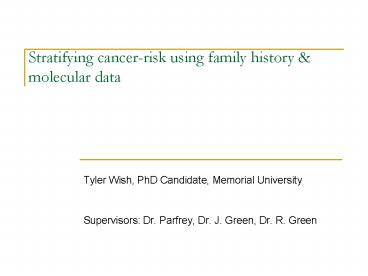Stratifying cancerrisk using family history - PowerPoint PPT Presentation
1 / 26
Title:
Stratifying cancerrisk using family history
Description:
Tyler Wish, PhD Candidate, Memorial University ... Identifying and stratifying high risk ... Etiology unknown. Familial Colorectal Cancer Type X (FCC-X) ... – PowerPoint PPT presentation
Number of Views:59
Avg rating:3.0/5.0
Title: Stratifying cancerrisk using family history
1
Stratifying cancer-risk using family history
molecular data
- Tyler Wish, PhD Candidate, Memorial University
- Supervisors Dr. Parfrey, Dr. J. Green, Dr. R.
Green
2
Outline
- Defining FCC-X
- NL Cancer Risk Data
- Identifying and stratifying high risk subgroups
with the use of - Family history criteria
- Molecular data
- Family history scores
3
Autosomal dominant CRC kindredsEtiology unknown
- Familial Colorectal Cancer Type X (FCC-X)
- Defined as Amsterdam I families without MMR
deficiencies - (Lindor et al, JAMA, 2005) - 30-60 of Amsterdam Cases fulfill FCC-X
- Compared to Lynch Syndrome
- Later CRC onset (55-60 years)
- Lack of extracolonic cancers Primarily CRC
- Lack of synchronous / metachronous cancer
- More often Left-sided
- Less often mucinous
4
NL Population-based Data
- Microsatellite stable, autosomal dominant, late
onset colorectal cancer may occur frequently in
the population. - Wish T, Green J, Green RC, Woods MO, Younghusband
HB, Dicks EL, Gallinger S, McLaughlin J,
Stuckless S, Parfrey PS
5
Research Purpose
- To investigate the relative size of kindreds
defined by family history criteria and genetic
definitions of risk - Focusing on microsatellite stable families
- Characterize their cancer-risk profiles
- To further identify subgroups of high risk cancer
kindreds based on family histories scores and
pathology - Aims
- More precisely identify subgroups of high risk
familial CRC kindreds - Identification of high risk kindreds leads to
proper screening and improved outcomes
6
Familial Risk
7
CRC risk stratified by familial and genetic
definitions
8
Lynch syndrome-Cancer Risk
9
(No Transcript)
10
Conclusions
- FCC-X accounts for a significant proportion of
Amsterdam kindreds (67) - Large FCC-X population
- NL FCC-X kindreds have similar cancer risk
profiles as other populations - Later age onset
- Primarily CRC
- Absence of synchronous / metachronous cancers
11
What about ACMAC and Bethesda Kindreds?
- Heterogeneity
- Significant heterogeneity amongst kindreds
fulfilling ACMAC and Bethesda criteria although
some similarities to FCC-X - Cancer risk profiles
- Clinical characteristics
- Age of onset
- Types of Cancer CRC versus extracolonic
- Explanations..
- Autosomal dominant disease
- Multiple allele, Low penetrant disease
- Sporadic clustering
- Family History Score
- A tool to independently evaluate familial risk
within these broad family history criteria
12
Family History Score (FHS)- Yang. Am. J. Epi,
1998.
- Family specific score
- Calculates deviation from expected cancer
incidence for each individual - Expected incidence
- age, race, gender specific U.S cancer incidence
from the Surveillance, Epidemiology, and End
Results (SEER) database
13
FHS Purpose?
- To identify subgroups of high-risk familial CRC
kindreds - Allows a more precise estimation of familial
cancer risk - Increases specificity of identifying high risk
families - Able to differentiate between CRC kindreds and
kindreds presenting with multiple malignancy types
14
FCC-ACMAC kindreds (n41)
15
FCC-ACMAC (n27) versus FCC-X (n18)CRC Risk
16
Utility of Family History Score
- FHS enabled us to more precisely identify
kindreds within ACMAC which are representative of
FCC-X - Remaining kindreds appear to be
- other disease?
- sporadic clustering?
- Demonstrated that the FCC-X population is
potentially twice as large as identified by the
Amsterdam I definition only
17
What about remaining MSS Bethesda Kindreds?
- Non-ACMAC Bethesda
- Expect a 2-4X increase in risk from population
risk - Lifetime CRC risk 15
18
Family History ScoreNon-ACMAC Bethesda MSS
kindreds (intermediate risk families)
19
Non-ACMAC Bethesda MSS kindredsCRC Risk
20
Microsatellite Stable High Risk Kindreds
identified by family history criteria and
FHSFCC-X (n18) / ACMAC (n27) / Bethesda
(n50)
21
Conclusion
- The combined use of family history criteria,
molecular data, and family history score enables
a much more precise and informative analysis of
familial risk - Our data suggest that potentially 15 of
families in this study cohort represent
microsatellite stable autosomal dominant disease
(FCC-X) - Sensitivity of identifying FCC-X kindreds with
Amsterdam I criteria is low - Size of the FCC-X is potentially significantly
larger than currently recognized - The specificity of identifying high cancer risk
kindreds with current criteria (Bethesda) is low
22
Future Work
- Model to predict cancer risk using clinical
criteria, FHS, and pathology - FHS may increase specificity of identifying high
risk families - Use available pathology data to further identify
and stratify cancer risk
23
Many Thanks
- Funding
- CIHR
- Supervisors Dr Parfrey, Dr. Green, Dr. Green
- Co-authors
- Newfoundland Research Team
24
FCC-X FHS
25
Lynch syndrome kindreds - FHS
26
Non-ACMAC Bethesda MSS kindredsLynch syndrome
cancer risk































